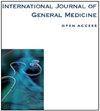Antimoniosis: Radiological Insights into a Rare Pneumoconiosis in Miners
IF 2.1
4区 医学
Q2 MEDICINE, GENERAL & INTERNAL
引用次数: 0
Abstract
Background: We aimed to investigate the radiological findings in individuals exposed to antimony-inert dust relative to their working periods.Objective: Fifty-six symptomatic male antimony miners were retrospectively evaluated for demographics and chest computed tomography (CT) scans.
Methods: The demographic and radiological data of patients with a history of antimony mining, who presented at our pulmonary clinic between June 2017 and June 2023, were analyzed according to the duration of exposure.
Results: The study included 56 male patients with a mean age of 58.5± 13.02 years and a mean exposure duration of 13.63 ± 6.82 years. CT scans showed that 73.2% (n=41) had upper and middle lung zone involvement, and 55.4% (n=31) had extensive involvement. Micronodules with centriacinar ground-glass opacities were the most common finding (n=37, 66.1%), followed by nodular opacities with irregular margins (n=22, 39.3%) and solid micronodules (n=20, 35.7%). Patients with over 20 years of exposure had significantly higher rates of respiratory and cardiovascular disease (p< 0.05). Increased exposure time correlated with more extensive parenchymal involvement and higher rates of calcification in mediastinal lymph nodes, solid micronodules, nodular opacities with irregular margins, honeycombing, and conglomerate mass appearance.
Conclusion: Radiological findings in pneumoconiosis generally worsen with longer exposure. Given the scarcity of up-to-date information on antimony pneumoconiosis, further studies focusing on radiological findings and chemical analyses of those exposed to antimony mine dust are essential to identify related pathologies.
抗尘埃沉着病:矿工罕见尘肺病的放射学启示
背景:我们的目的是调查暴露于锑惰性粉尘中的人在工作期间的放射性结果:我们的目的是调查接触锑惰性粉尘的人在工作期间的放射学结果:对 56 名有症状的男性锑矿工人进行了人口统计学和胸部计算机断层扫描(CT)回顾性评估:根据接触锑的时间长短,对 2017 年 6 月至 2023 年 6 月期间在我院肺科门诊就诊的有锑矿开采史的患者的人口统计学和放射学数据进行分析:研究共纳入 56 名男性患者,平均年龄(58.5±13.02)岁,平均接触时间(13.63±6.82)年。CT扫描显示,73.2%(41 例)的患者肺上部和中部受累,55.4%(31 例)的患者肺部广泛受累。微小结节伴有向心性磨玻璃不透明是最常见的发现(37 人,66.1%),其次是边缘不规则的结节性不透明(22 人,39.3%)和实性微小结节(20 人,35.7%)。暴露时间超过 20 年的患者患呼吸系统和心血管疾病的比例明显更高(p< 0.05)。接触时间越长,肺实质受累范围越广,纵隔淋巴结钙化、实性微结节、边缘不规则的结节性不透明、蜂窝状和团块外观的发生率也越高:结论:尘肺病的放射学检查结果通常会随着暴露时间的延长而恶化。由于有关锑尘肺病的最新资料很少,因此必须对接触过锑矿尘的人进行放射学检查和化学分析,以确定相关的病理变化。
本文章由计算机程序翻译,如有差异,请以英文原文为准。
求助全文
约1分钟内获得全文
求助全文
来源期刊

International Journal of General Medicine
Medicine-General Medicine
自引率
0.00%
发文量
1113
审稿时长
16 weeks
期刊介绍:
The International Journal of General Medicine is an international, peer-reviewed, open access journal that focuses on general and internal medicine, pathogenesis, epidemiology, diagnosis, monitoring and treatment protocols. The journal is characterized by the rapid reporting of reviews, original research and clinical studies across all disease areas.
A key focus of the journal is the elucidation of disease processes and management protocols resulting in improved outcomes for the patient. Patient perspectives such as satisfaction, quality of life, health literacy and communication and their role in developing new healthcare programs and optimizing clinical outcomes are major areas of interest for the journal.
As of 1st April 2019, the International Journal of General Medicine will no longer consider meta-analyses for publication.
 求助内容:
求助内容: 应助结果提醒方式:
应助结果提醒方式:


